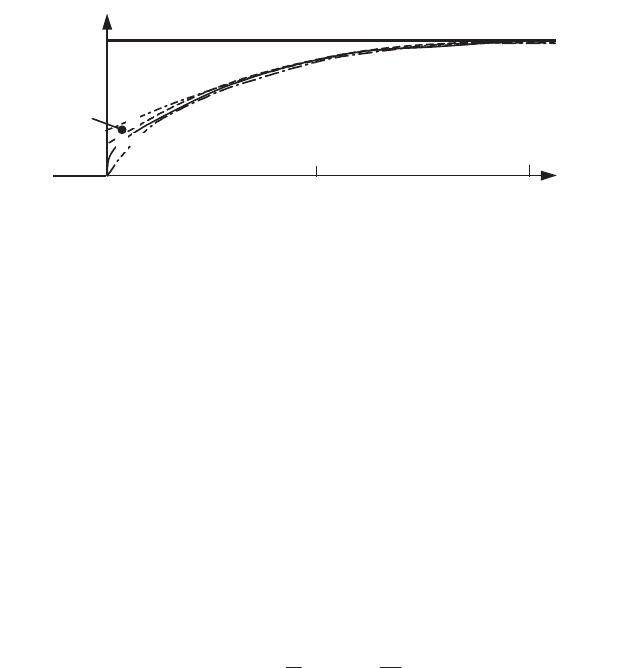Peube J-L. Fundamentals of fluid mechanics and transport phenomena
Подождите немного. Документ загружается.


462 Fundamentals of Fluid Mechanics and Transport Phenomena
W
T
W
K
TK
K
T
w
w
w
w
w
w
24
1
2
2
[8.87]
This equation is of a form analogous to [8.86] where the differentiation operators
are separated into two parts, the time derivative constitutes the perturbation term.
The calculation is performed as before and we seek a series development of
functions in separated variables:
¦
f
0
,
i
ii
fg
KWWHKT
[8.88]
Letting
K
K
K
d
d
d
d
M
24
1
2
2
, equation [8.87] can be written:
W
T
WT
w
w
M
We obtain the recurrence relations:
!!!!
!!!!
WWWKK
WWWKK
WWWKK
W
K
'
11
'
1212
'
0101
00
,
0
iiii
w
ggffM
ggffM
ggffM
TgfM
[8.89]
which are associated with the boundary conditions:
f f f ,,2,100;10;,,2,1,00
0
!! iffif
ii
Taking account of the conditions at infinity, the function f
0
(
K
) is (see section
5.4.5.4):
K
K
erff 1
0
The analytical calculation of the functions f
i
is difficult: even if the solution to
the homogenous equation
0
K
i
fM can be expressed easily as a function of a
multiplicative constant (section 5.4.5.4), the variation of constants method is
impractical on account of the complexity of calculations. A numerical solution,

Thermal Systems and Models 463
which is preferable, makes the easy calculation of the first functions f
i
possible. The
series of functions f
i
is alternated and tends asymptotically to two functions equal to
K
f
r f which can be easily determined from system [8.89]:
with: 0 0Mf f f f
dd d d
d
The reader can verify that we have:
2
exp( ) ( : constant)f c c
d
However, the recurrence relation
WWW
'
1
ii
gg
does not provide a simple
expression for the functions g
i
. Furthermore, we note that the perturbation term
W
T
W
ww of equation [8.87], of order
tTtT
ww
'
W
in relative value, must remain
quite small: the temporal derivative of the imposed temperature must decay quickly
enough as time increases. From a physical point of view, it seems natural that in
order to remain as a small perturbation, the imposed temperature variation decreases
with time as the temperature distribution of the base solution T
0
spreads (Figure
8.6). In order to render the perturbation uniform in time, we compress the time scale
by performing the temporal variable change:
WW
ii
gtGt
ˆ
ln
,
which simplifies recurrence relation [8.89] of the functions g
i
, which can be written:
!!!!!!!!!
tTtGtG
tTtGtGtTtGtTtG
i
wii
www
ˆˆˆ
ˆˆˆˆˆˆˆ
)(
'
1
''
'
1
'
2
'
10
[8.90]
The parametric expression of the solutions for the thermal shock is thus:
¦
f
0
)(
ˆ
,
i
i
i
w
ftTtxT
K
[8.91]
The derivatives of the function T
w
(t) being taken with respect to the variable
tt ln
ˆ
.
The thermal flux density at the wall can be written:
¦
f
w
w
0
'
)(
0
0
ˆ
2
1
i
i
i
w
x
Tw
ftT
at
x
T
q
O
O

464 Fundamentals of Fluid Mechanics and Transport Phenomena
The values of the derivative
0
'
i
f
are shown in Table 8.2.
i 0 1 2 3 4
2/)0(
'
i
f
–0.5642 –0.7821 0.3859 –0.3203 0.2985
i 5 6 7 8 9
2/)0(
'
i
f
–0.2897 0.2857 –0.2838 0.2829 –0.2826
Table 8.2.
Values of the derivative
0
'
i
f
The preceding method can also be applied to the expression of solutions in the
vicinity of the base solutions of the form
K
ft
n
. In particular, it is easy to verify
that the value n = 1/2 corresponds to the constant thermal flux which is given at the
wall. The solutions where the thermal flux varies gradually can be obtained as
before.
8.5.3.3.
Harmonic solutions of the equations for continuous media
The method described in section 8.5.2.4 can be applied to continuous media by
eliminating the temporal variable of the partial differential equation of the problem.
Let us take the example of temperature oscillation applied to the surface of abscissa
x = 0 of a semi-infinite wall. We encounter this problem of oscillatory thermal
penetration into rocks or ground which is subjected to daily or annual temperature
variations. Assuming a homogenous medium, the temperature
txT , satisfies heat
equation [8.32] with the following boundary conditions:
00
2
2
,;cos,0; TtTtTtT
x
T
a
t
T
f4
w
w
w
w
Z
[8.92]
We seek solutions of the form:
xfeTT
tj
Z
4
0
The heat equation becomes a differential equation:
xaffj ''
Z
whose characteristic equation (
0
2
Z
jra ) has roots:
Z
ajr 2/1 r .

Thermal Systems and Models 465
The real solutions sought for the temperature distribution can be written:
G
Z
G
xtxTT 4 cosexp
0
The depth
ZG
a2 is a space constant for the thermal damping oscillation.
The solution represents a temperature oscillation which becomes damped with
increasing depth. A numerical application shows that this damping is fast: taking a
value of 10
-6
m
2
.s
-1
for the thermal diffusivity of the ground (corresponding to an
average rock), we find that
G
is respectively equal to 0.17 meters and to 3.15 meters
for daily and annual oscillations of temperature. The oscillation phase is opposite at
a depth of
G
/2 where amplitude has been reduced by a factor equal to 1.65.
The complex amplitudes method can be applied equally well to problems defined
in finite domains (walls, cylinders, etc.).
8.6. Model reduction
8.6.1. Overview
The objective of a knowledge model is to capture the evolution of a system, the
sub-system interactions of which we do not know. It comprises a large number of
variables in order to represent all the possible properties. The results involve either a
large quantity of numerical results from a computer solution or analytical
representations which may be more or less complex. The use of a knowledge model
amounts to performing a numerical experiment, which is often less expensive than a
physical experiment. A model is often too complex for a simple description of a
particular category of evolutions. Reduction of this model consists of replacing it
with a reduced model having a smaller number of variables, and whose objective is
to represent the principal phenomena with regard to the objective which is defined
(physical understanding of the model mechanisms, elaboration of a simulation
program or engineering formulae, control of processes). We are therefore interested
in decomposing the system into a small number of components with relatively
simple properties and whose interactions can provide a representative description of
the system in fixed conditions. Of course, the reduced model is not adapted to the
study of other operating conditions in the system.
Model reductions can be performed using various methods. However, the value
of the results of a model or of an experiment always depends on the pertinence of the
original hypotheses, on the reasoned use of numerical solutions or physical
measurement techniques and on a suitable physical analysis of the phenomena.
Certain methods consist of the performance of a numerical solution of a system by
means of a knowledge model, and the coupling of inputs and outputs with

466 Fundamentals of Fluid Mechanics and Transport Phenomena
representations of an empirical form which can be obtained by least mean square
methods; this practice has been used for a long time in order to establish engineering
formulae for certain applications. It has evolved into more sophisticated forms
through the use of more sophisticated mathematical methods. The use of these
methods is only justified as a method of exploiting the calculations resulting from a
physical analysis, which evaluates the nature of the approximations that are made
and the relative importance of the components in the functioning of a system. We
will prefer methods which increase our physical knowledge of the system studied,
and we will assume that the variables of the knowledge model have a physical
meaning and are not simply numerical values collected from experiments.
8.6.2. Model reduction of discrete systems
8.6.2.1. Principles of reduction of the state representation
A knowledge model, in the form of a state representation of a system with n state
variables or of an equivalent representation (an nth order differential equation in one
variable, etc.) makes the detailed description of all possible evolutions of the system.
The complexity associated with a large number n of variables leads to it being
replaced by a model with s state variables (s < n), called a reduced model, the
objective of which is to represent a particular evolution of the given physical system
(including its inputs and outputs) with good accuracy, or more general evolutions
with reduced precision. We have already seen some examples in section 8.3.2.2.3.
By definition, a differential system of order s cannot be equivalent to a
differential system of order n (n > s); however, these systems may have an identical
behavior for a family of solutions which depend on at most s parameters. The
reduction in the number of variables appearing in the differential equations can only
come from a regrouping of the equations, allowing the replacement of several
variables by a single variable or simplification of the equations, which lose their
differential character. Consider knowledge model [8.93]:
XDYUBXA
dt
dX
...
[8.93]
Consider the reduced state vector X
r
with s components (s < n) derived from X
by a passage matrix R from X to X
r
(X
r
= R X); the state vector X
r
satisfies the
reduced state representation:
rrrrr
r
XDYUBXA
dt
dX
..
[8.94]
with conditions [8.95] obtained by multiplying the left-hand side of equation [8.93]
by R and by comparing with [8.94]:

Thermal Systems and Models 467
.00;; DRDRXXRBBRARA
rrrr
[8.95]
If conditions [8.95] are exactly satisfied, representation [8.94] is an exact
reduced model for the ensemble of solutions X of [8.93] such that RX is non-zero.
However, in general, with the exception of cases where these solutions are known
explicitly, the realization of an exact reduced model is impractical.
Assuming conditions [8.95] are not satisfied, reduced representation [8.94] is an
approximate reduced model. The reduced vector X
r
= RX of the solution X of [8.93],
does not exactly satisfy equation [8.94]; if q is the residuum, the error of equation
[8.94]:
qUBXA
dt
dX
rrr
r
..
[8.96]
Let
r
X
ˆ
be a solution of [8.94]:
UBXA
dt
Xd
rrr
r
.
ˆ
.
ˆ
[8.97]
We define the error
rr
XXe
ˆ
with respect to the exact solution
r
X
ˆ
assumed
to be verified by equation [8.94]; it satisfies the differential equation obtained by
subtracting term by term [8.96] and [8.97]:
UBXA
dt
dX
eAqeA
dt
de
rrr
r
rr
..
We must therefore determine the matrices R, A
r
and B
r
, such that the error of
equation q is minimized. This minimization procedure can be performed on an
ensemble of known solutions. We will leave aside the details of this kind of
procedure.
It is easy to impose that the reduction be exact for the steady regime. In this case,
equations [8.93] and [8.94] can be solved and we obtain:
BURARXUBAX
rrr
11
.
and consequently the relation:
BRAAB
rr
1
.
In the unsteady regime, the preceding elimination is no longer possible and the
vector RX obtained with the solution of [8.93] is no longer equal to the solution
r
X
ˆ
468 Fundamentals of Fluid Mechanics and Transport Phenomena
of [8.97]. The matrix A
r
can be determined by minimizing the error of equation q.
This minimization can be performed for chosen inputs and for criteria which need to
be defined for the weighting to be applied at different instants [PET 91]. This
procedure comes down to performing a numerical interpolation on the knowledge
model by means of a reduced model.
8.6.2.2.
Physical aspects of the model reduction
The considerations of the preceding section are essentially of a mathematical
nature and they leave a wide choice for the variables (in particular the matrix R), the
class of solutions and the objectives of error minimization. They can be applied to a
perfect knowledge model from the perspective of thermodynamics (sub-systems in
quasi-equilibrium), this needing to be verified for solutions which vary quite slowly
in space-time. The reduction in a knowledge model can only have a limited interest
if the discretization is too rough in certain domains. The partitioning of a system into
sub-systems is the most important operation and we will assume that it is suitable. In
general, the reduction in the number of variables is associated with a regrouping of
components, which leads to a choice of the reduced variables to be retained; this
should be done such that the definition of the mean intensive variables of the sub-
systems of the reduced model have a reasonable physical meaning in the balance
equations (section 1.4.2.5 and section 6.5.2.4).
The grouping of sub-systems which are in neighboring or identical states leads to
the replacement of many differential equations by a single equation: for example, a
material domain which has been segmented into three components and whose
temperatures are close can be represented by a single component at a suitable
temperature whose thermal energy is the sum of the energies of the components.
The sub-systems whose extensive quantity contents are small can often be
eliminated or assimilated into neighboring components, leading to the suppression
of the corresponding variables. The components whose extensive quantities are
constant or vary little can become sources of established fluxes: they thus play a role
of a simple resistance for the transfer of extensive quantities and their modeling
loses its differential character. We have seen two examples in sections 8.3.1.3 and
8.3.1.4.
In general, the number and the size of the sub-systems (or the grid of the system
domain) must be adapted to the categories of the solutions studied. Let us take the
example of the discretization on a continuous medium of a wall whose surfaces are
subjected to a thermal shock (section 8.3.2.2.2). Let us begin by segmenting the wall
into 50 equal elements in series (a system analogous to that of section 8.3.1.3).
Figure 8.13 shows that the temperature variations in the first instances are rapid in
the vicinity of the wall surface, whereas later, they become quite regular. The
discretization in equal elements is thus not the best solution: a finer discretization is

Thermal Systems and Models 469
needed in the vicinity of the wall surfaces if we want to have a suitable precision in
the first instants, whereas such a fine discretization is not necessary later in the
central part of the wall. A better result with 50 elements is obtained when these are
distributed broadly at the center of the wall, and extremely close to the edges of the
wall.
8.6.2.3.
The problem of local constraints
However, many systems present local constraints (in the mathematical sense) on
certain intensive variables related to the possible modification of material elements:
deteriorations due to excessive temperature or to large
8
instantaneous stresses. In
this case, we obviously cannot eliminate from the model the small component which
contains, for example, a small thermal energy, but which possesses a critical
temperature value (temperature of a thermal measurement probe, a fragile element
whose temperature must be limited, etc.). The intensive variable concerned (often
the local temperature) is necessary for the regulation of a controller whose job it is
to modify or stop the system functioning. Model reduction in such zones is
obviously delicate.
8.6.2.4.
Modal reduction of time-invariant linear systems
8.6.2.4.1.
Introduction
Modal reduction is essentially concerned with time-invariant linear systems
whose transitional solution is the sum of eigenmodes of the system of equations (see
the examples of discrete or continuous systems in section 8.3). The solution of a
linear system can be expressed in an explicit modal form using initial conditions and
an established solution (section 8.2.2.2); the reduction here amounts to a
simplification operation, but the question regarding the pertinence of the different
modes arises for discretized systems. We are then interested in writing a reduced
state representation which will allow the numerical simulation of the system in
complex conditions.
8.6.2.4.2.
Modal reduction of continuous solution of continuous media
The modal solution of the heat equation involves replacing the continuous
variable by a denumerable set of mode coefficients in the explicit expression of
solution [8.38] in the form of a series. The reduction problem therefore consists of
simplifying and/or truncating this series. A consequence of this truncation is the
introduction of a discontinuity at the time origin, which amounts to assuming that
8
For example, cavitation (vaporization and chiefly sudden condensation) when local pressure
in a liquid flow is less than the saturation vapor pressure, high temperature on a wall in high
supersonic or hypersonic air flow, production of pollutants inside engines or chemical
reactors due to local bad conditions of temperature or concentrations, etc.

470 Fundamentals of Fluid Mechanics and Transport Phenomena
fast energy transfers in the higher order modes occur instantaneously (section
8.2.2.2). Various authors avoid this discontinuity by adding a fictitious mode or by
attributing to the last mode retained the total remaining amplitude. Let us illustrate
this problem by reconsidering the example of thermal shock on the wall edges
(section 8.3.2.2.2).
t
~
T
1
T
0
T
m
(t)
1
2
3
4
1 20
Figure 8.17.
Mean temperature on a wall during a thermal shock on its two faces
(section 8.3.2.2.2). The draughts are indicative
Let us consider the mean temperature T
m
(formula [8.41]), which translates the
thermal energy evolution over the course of the heating processes caused by the
thermal shock (curve 1, Figure 8.17). We have seen (Table 8.1) that the first mode
contains 81% of the process energy; in only conserving this first mode, we obtain a
representation for the temperature T
m
(curve 2, Figure 8.17), which contains a
discontinuity at the origin equal to
10
019.TT ; considering the first two modes of
the series representing T
m
(curve 3, Figure 8.17) this discontinuity is reduced to
10
010.TT ).
We can remove this discontinuity by including the total remaining amplitude
(0.19 in relative units) in the highest mode retained (curve 4, Figure 8.17) in
accordance with the formula:
22
9
44
101
081 019
tt
m
T(t) T T T [ . . ]
ee
SS
However, the second mode is now too large; we can therefore look to determine
a time constant of the second mode in order to achieve a better representation of the
function
T
m
(t), for example by a mean square error minimization method. It is also
possible to add a fictitious mode. It is clear that a good solution is not achieved and
the values obtained by empirical adjustments are not physically pertinent.
Thermal Systems and Models 471
In effect, in the first instants of the evolution, only zones in the vicinity of edges
are concerned with the heat transfer. Further from these, the sum of the series terms
[8.41] is zero:
the modal representation is not adapted to the representation of a
thermal boundary layer problem
(section 8.3.2.2.2). We can obviously note that the
thermal boundary layer is independent of the wall thickness
A
that can take any
value: defining modes by means of an arbitrary length is indeed an irrational method
which cannot lead to a judicious mathematical representation.
A good reduced model of thermal conduction in a wall must also take into
account the modal aspect as the evolution of the unsteady boundary layer. There is
no other (or nearly no other) way to obtain such a reduced model than
a composite
representation
matching the modal representation and the thermal shock solution:
we have presented this method in section 8.3.2.2.3, where a good precision was
obtained for the mean temperature [8.46], using only the first mode. This method
also has the advantage of giving precise values for the thermal flux density at the
edges [8.47] at any instant.
8.6.2.4.3.
Modal reduction of discrete models
In section 8.6.2.2 we considered the model with 50 elements of a continuous
wall subjected to a thermal shock, leading to a linear system with 50 variables, and
which thus comprises 50 eigenvalues and eigenmodes. We will consider that a half
period of a sinusoid requires at least ten intervals in order to be represented by a
constant function in each element. The interval under study cannot therefore
comprise more than five arches: we can only represent the first three even modes
and the first two odd modes (see Figure 8.12). The 45 other modes are increasingly
noisy as the order is increased (the 50
th
mode corresponds to a change of sign of the
eigenfunction between each of the 50 intervals). Their physical existence is
increasingly problematic and it is not useful to consider them despite the fact that
they constitute exact solutions of the model.
A discretization into sub-systems should comprise a sufficiently large number of
elements, but only a few modes are actually useful
. The modal solution is obviously
the most interesting because it provides a structured knowledge which highlights the
system properties. However, the discretization of a linear system proceeding from
the calculation of its modes requires more elements than a discretization, taking into
account physical aspects and particularly the level of unbalance between two
neighboring sub-systems: if we consider the preceding example of the wall on the
interval [-1,+1], it is necessary to calculate the modes to be retained over the entire
interval, whose form (Figure 8.12) requires discretization of the interval [-1,+1] in
equal segments, as opposed to a numerical resolution for which a discretization,
narrower near the wall faces and wider in the central part, is more fitted to the form
